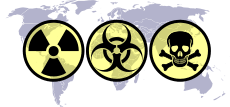Unit 100
| Weapons of mass destruction |
|---|
 |
| By type |
| By country |
|
| Proliferation |
| Treaties |
|
Unit 100 (第百部隊 (dai-hyaku butai)) was an Imperial Japanese Army facility officially called the Kwantung Army Warhorse Disease Prevention Shop[1] that focused on the development of biological weapons during World War II. It was operated by the Kempeitai, the Japanese military police. It was located in Mokotan, Manchukuo, a village just south of the city of Changchun.
Mission
The main purpose of Unit 100 was to conduct research about diseases originating from animals. As most armies were still heavily dependent on horses, the Imperial Japanese Army hoped to find ways to kill them and therefore to weaken military power. Furthermore, they hoped to spread disease via animal carriers. To this end, former members claim that experiments were also conducted with human beings. In practice, Unit 731 was the group tasked with developing biological weapons against humans. Although smaller than Unit 731, Unit 100 was still a large organization. Its annual bacteria production capacity was projected to reach 1,000 kg of anthrax, 500 kg of glanders, and 100 kg of red rust (fungus). The goal was never reached, due to equipment shortages.
Senior Sgt. Kazuo Mitomo described some of Unit 100's human experiments:
"I put as much as a gram of heroin into some porridge and gave this porridge to an arrested Chinese citizen who ate it; about 20 minutes later he lost consciousness and remained in that state until he died 15-16 hours later. We knew that such a dose of heroin is fatal, but it did not make any difference to us whether he died or lived. On some of the prisoners I experimented 5-6 times, testing the action of Korean bindweed, bactal and castor oil seeds. One of the prisoners of Russian nationality became so exhausted from the experiments that no more could be performed on him, and Matsui ordered me to kill that Russian by giving him an injection of potassium cyanide. After the injection, the man died at once. Bodies were buried in the unit's cattle cemetery."
Unit chief Yujiro Wakamatsu ordered Hirazakura to purchase hundreds of cattle and put them to pasture along the Soviet border north-east of Hailar, ready to be infected by airborne dispersion. It was hoped that in the event of a Soviet invasion these infected livestock would mingle with local herds to cause epidemics and to destroy food supplies.
Biological warfare agents
The following potential agents were tested:
- Yersinia pestis, which causes plague
- Burkholderia mallei, which causes Glanders in horses: Kuwabara gave testimony after World War II that Unit 100 released horses infected with Glanders.
- Bacillus anthracis, which causes anthrax
See also
References
- ↑ 秦郁彦 『昭和史の謎を追う (上)』 文春文庫、1999年 ISBN 4-16-745304-5. p.546.